Comment Period Ends August 22, 2019
The UK government is considering adding objects made of walrus, narwhal, whale, warthog, hippopotamus, and even extinct mammoth ivory to its Ivory Law, which in its current form covers only elephant ivory. The law is expected to come into effect in late 2019, although a legal challenge to it is pending. The UK’s Ivory Law gives government the power to extend the ban on trading in elephant ivory to other species. The government is seeking commentary from dealers, collectors, conservationists, law enforcement and any others who would be affected by a ban on trade and export of non-elephant ivory. Specifically, it is looking for whether the markets in objects made from walrus, narwhal, whale, warthog, hippopotamus, and mammoth “pose a threat to their long-term survival or are linked to illegal wildlife trade.”
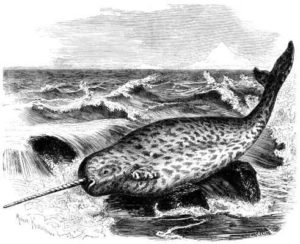
Narwhal. Brehms Thierleben. Allgemeine Kunde des Thierreichs, Zweiter Band, Erste Abtheilung: Säugethiere, Dritter Band: Hufthiere, Seesäugethiere, Zweite umgearbeitete und vermehrte Auflage, Kolorirte Ausgabe, Leipzig: Verlag des Bibliographischen Instituts, 1883.
The UK’s Department for Environment, Food and Rural Affairs (Defra) is seeking public comment. Make your voice heard, whatever perspective you hold!
To comment, access the online survey: https://consult.defra.gov.uk/communications/non-elephant-ivory-trade/
Your comments may consider a variety of issues, from the comparative amount of market interest in antique and contemporary specimens, conservation and wildlife management of the listed animals, the impact on native Arctic peoples or African communities, and the limited demand for objects made of these materials.
Below, we outline key arguments regarding adding walrus, narwhal, whale, warthog, hippopotamus, and extinct mammoth ivory to the U.K. Ivory Law:
- Market realities show that only antiques, not living animals, would be affected by adding marine mammal, warthog, hippo teeth, and mammoth ivory to the UK ivory law.
- UK ivory law should, but does not allow general trade in antiques. Not only would decorative walrus carvings by both ancient and contemporary Native artisan be illegal to trade, virtually every woman’s dress and corset from the 18th – 19th century would be unlawful to buy or sell, as they used whalebone for corsetry and supports.
- Wildlife trade expert says current UK elephant ivory law has “little or no effect” on elephant sustainability; it only affects antiques.
- Walrus, whale, and narwhal populations are already protected by well-enforced domestic legislation in range countries in the Arctic. Animals are hunted for food, not ivory. There is no “collectors market” for marine ivory, except for traditional Native carvings from Canada and US. Only Canada allows export.
- Native artists and carving traditions are severely threatened in US, after passage of ivory laws by states banning all ivories.
- Minuscule African trade in warthog tusks and hippo teeth does not substitute for illegal ivory trade.
- Warthogs are common, not threatened, and hippo populations are sustainably manageable, not at risk.
- Wildlife specialists agree that better documentation of domestic and international trade in endangered species is the most valuable and important step to preserve animal populations.
- Making trade illegal in long-extinct animal parts from mammoths has no conservation value. Mammoth ivory is not easily confused with elephant ivory, and is part of economically necessary carvings trade by indigenous peoples in the Arctic. Vast stores of mammoth ivory, estimated at 500,000 tons are now being exported by Yakutia to China, where it is being sold as an “ethical alternative” to elephant ivory.
- Eliminating a trade in the UK that is almost exclusively in antiques will harm small businesses, private collectors, museums, researchers and students of everything from antiquities to ladies antique dresses, without preserving threatened animals.
Summary: What will be affected as a result of expansion in the UK? Only antiques.

Ball gown, Great Britain (probably), ca. 1885, Moiré silk, machine lace, silk, cotton and whalebone. Victoria & Albert Museum, London, T.429&A-1990.
The issues raised by expanding the Ivory Law to walrus, narwhal, whale, warthog, hippopotamus, and extinct mammoth are very different from those which prompted its enactment in 2018. That very restrictive law was prompted by fears that any ivory trade – even in antiques – would make it more difficult to police the flow of the over 95% of elephant ivory that currently goes to Asian markets.
The proposed UK law covers materials found primarily in the Arctic and in Africa, although fossilized mammoth ivory has been found all over the world, including by being pulled up in ocean-fishing nets. The two regions, Arctic and Africa, have very different legal systems and enforcement of environmental and endangered species laws.
Although the animals under consideration for a ban in trade are in some cases deemed endangered, they are threatened by climate change and environmental and development pressures where they live, not by trade in their ivory. US, UK and European trade in their ivory in most cases does not exist except for antiques, and for Arctic peoples, carving ivory is an income-producing byproduct of specially permitted subsistence-hunting for food.
In the Arctic, for example, while several nations allow trade in marine mammal products for internal, domestic use, only one, Canada, allows any export of endangered narwhal, and the trade is very closely regulated. Hunting of arctic walrus and narwhal is only permitted for indigenous peoples. Communities in the Arctic region are often dependent upon the meat and skin of walrus, narwhal, and whales to maintain traditional lifeways, and all governments in the Arctic region acknowledge the importance of preserving hunting, feasting, and carving traditions. Laws are strict and closely enforced. In any case, as the data below shows, there is more than enough raw material available as a byproduct of hunting for food than is needed to satisfy demand for carved objects made from these creatures bone or ivory.
The commercial trade in Arctic mammal ivory is far smaller than personal collecting in Scandinavian countries and Japan, the countries to which marine mammal ivories are most exported. Even there, exports are from one to 25 objects per year. There has been little evidence of an illegal market for marine mammal products of any kind outside of the Arctic itself for the last twenty years.
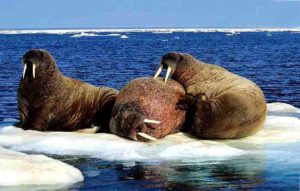
Part of Atlantic walrus herd (Odobenus rosmarus rosmarus), on ice flow in Foxe Basin (Nunavut, Canada), Author Ansgar Walk, 29 July 2001, Creative Commons Attribution-Share Alike 3.0 Unported license.
In Africa, warthogs exist in plenty, and there is little demand for their tusks. Hippopotamus populations are potentially at risk, but many wildlife specialists see these populations as manageable. (Hippos are listed as “vulnerable” on the IUCN Red List, not endangered, but at risk of becoming so.)
There is no market for recently made hippo products in the U.S., Europe, or the U.K., and there are only a small number of antique items of hippopotamus ivory in circulation outside of Asia.
In the main, researchers in sustainable wildlife practices appear far more concerned about updating and improving overall documentation of all endangered species under CITES than about risk to animals in proposed expansion of UK law.
The greatest concern about the effect of an expansion of ivory law in the UK is that it would make it more difficult to preserve antique examples of art made from these materials.
Current law in England and Wales

Evening dress, designed about 1912, Lucile (1863-1935), Satin, trimmed with chiffon, machine-made lace; silk velvet; bodice supported with whalebone. V&A Museum no. T.31-1960
It is important to look at the scope of the present UK ivory law, because other species added to it would be subject to similar restrictions. In December 2018, the UK implemented what is possibly the world’s most restrictive law on the trade in elephant ivory. The UK’s Ivory Law covers not only raw ivory and recently-made items, but has also eliminated trade in the majority of antique and ancient objects made of or containing ivory, including European, Islamic, and Asian art and artifacts.
Under the new UK law, legally acquired antique and ancient objects will remain legal to possess, but not to sell, and if the ban is extended to other species, similar restrictions are likely. There are some very limited exceptions to the ban on the sale of elephant ivory. Portrait miniatures on very thin sheets of ivory that are over 100 years of age are not covered. Musical instruments made before 1975 with no more than 20% of ivory by volume may be sold. Objects made before 1947 with a minimal ivory content (such as some inlaid furniture) may be sold but only if they contain no more than 10% ivory by volume.
The UK government has ensured access to exceptional ivory objects for public museum collections by allowing legal sales of all ivory items to museums and from one museum to another. There is also a very narrow exemption allowing sales of the ‘rarest and most significant items of their type’ of antiques over 100 years of age – with official approval. The way in which the law is written gives UK museums a considerable ‘edge’ in acquiring objects at the price they want, since if rejected by museum-based experts as not qualifying as the rarest of the rare, the object can only be sold to a museum.
Market representatives strongly objected to including antiques in the ban. They argued that halting trade in raw ivory and new carvings was what was essential to preserve elephants from extinction. They also made the point that severely restricting the trade in ancient and antique items was likely to result in the destruction of hundreds of thousands of works of art, knickknacks and antique items that did not qualify for legal sale, and if valueless, would simply be thrown away, damaged, or destroyed.
Wildlife trade expert says UK’s elephant ivory law has “little or no effect” on elephants

Humpback whale (Megaptera novaeangliae), Resurrection Bay, Seward, Alaska, United States, Author Diego Delso, delso.photo, License CC-BY-SA, 21 August 2017.
In an interview in December 2018, Dr. David Roberts, Academic Head of Conservation Biology in the School of Anthropology and Conservation at the University of Kent, discussed the possible expansion of the law to non-elephant ivories. Roberts, a specialist in illegal wildlife trade, described the Ivory Law as “a bit of a PR stunt” with little or no effect on the poaching of elephants, saying that in the UK, the law, ‘Essentially… criminalises antiques.”
Dr. Roberts had even harsher criticism of the possibility of expanding the law to cover non-elephant ivories including walrus, narwhal, hippo, whale, warthog and mammoth.
“People no longer hunt toothed whales to any degree and certainly not for their teeth, therefore why ban a trade in what is largely antique or with potentially some beach salvaged teeth? Banning walrus and narwhal will disenfranchise communities in the Arctic who have few resources due to the environmental conditions. The only potential issue is hippo where the current ban on elephant ivory could move the attention of poachers as a source. However, hippo populations are still comparatively large and could be managed.”
Dr. Robert’s concern about the residual impact of a ban on the economy of Arctic peoples is real. In the U.S., laws allow only Native Americans to have access to fresh and uncarved marine mammals’ bone and ivory. The U.S.’s 1972 Marine Mammal Protection Act[i] protects sea otter, walrus, polar bear, dugong, and manatee. New marine mammal ivory may be carved only by Alaska Natives and sold to the public only after it has been carved. However, old ivory can be carved by non-Natives, and fossilized mammoth ivory may be used by both Alaska Natives and non-Natives. Once carved, all are legal to trade within the U.S. under federal law, although CITES, the Convention on International Trade in Endangered Species, restricts export of protected species except for objects over 100 years old.
Impact on Native communities
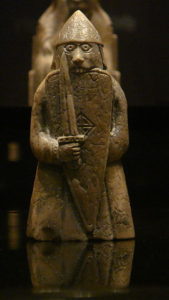
Piece from the Lewis Chessmen from an exhibition in the National Museum of Scotland. A queen and a warder (rook). Author Nachosan, 10 August 2010, CC-SA-3.0 license.
The U.S.’s recent interstate ban on trade of all but legally acquired antique elephant ivory has had an unintended impact on the Native Alaskan craftsmen who carve marine mammal ivory. Many Native artisans depend on sales of carved marine mammal ivory, particularly walrus, to pay for necessities like fuel oil through the winter.
Public confusion about what types of ivory are covered by the federal elephant ivory ban has reduced Native carvers’ earnings by as much as 40%, according to recent press reports. The once-popular Native crafts are now disdained by visiting tourists due to negative associations with poached elephant ivory.
In addition, several U.S. states have passed their own laws prohibiting trade in both elephant and marine mammal ivory. New York bans trade in mammoth ivory, including fully fossilized ivory. California has gone further than any other state, banning all ivory. In California, “ivory” means a tooth or tusk from a species of elephant, hippopotamus, mammoth, mastodon, walrus, warthog, whale, or narwhal, or a piece thereof, whether raw ivory or worked ivory, and includes a product containing, or advertised as containing, ivory.”
The losses suffered by Native Alaskan craftspeople were so alarming that Alaska Senators Lisa Murkowski and Dan Sullivan introduced a bill in 2017, the Allowing Alaska Ivory Act, which would have prohibited any U.S. state from banning sales, trade, or possession of handicrafts made of walrus ivory, whale bone, fossilized mammoth ivory or fossilized mastodon ivory if the handicrafts were made by Native Alaskans. The bill did not pass, leaving Native carvers in doubt whether their industry can survive.
Restrictive laws discourage preservation of objects
Many people in both the US and UK who have inherited ivory or collected antique ivory objects do not know what to do with them. Museums already have significant ivory collections and few are willing to accept objects as gifts unless they are of extraordinary quality.
Campaigns by environmentalist groups have focused on building antipathy to ivory in the UK and US public, including against antique ivory. For the most part, the public does not realize that the threat to elephants comes from Asian markets, where almost all illegal ivory is now traded, not from trade in antique and ancient objects in Europe and the US.
Recent find of Lewis Chessman carved from walrus ivory
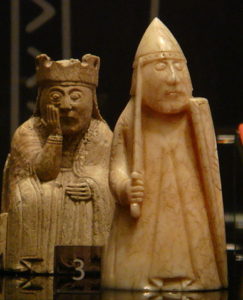
Pieces from the Lewis Chessmen from an exhibition in the National Museum of Scotland. A queen and a warder (rook). Author Nachosan, 10 August 2010, CC-SA-3.0 license.
Recently, a missing piece belonging to the world famous 12th century Lewis Chessmen set was discovered. The piece, a small warder or rook, had been left unnoticed in a drawer for at least 55 years.
This discovery raised an interesting question. If all forms of ivory were illegal to trade, would anyone have bothered to do the research to investigate its history and realize its incredible rarity and importance? Would it simply have been discarded as something too much trouble to deal with, unworthy of preservation, and tainted by association with poaching… instead of being sold in July 2019 for £735,000?
(The Lewis Chessmen are not only famous as antique objects; they were copied to serve as the model for the game of Wizard Chess played by Harry Potter and Ron Weasley in the first Harry Potter film, The Sorcerer’s Stone.)
Sustainable walrus populations
According to the most recent full-length publication on the walrus trade by TRAFFIC[ii], the wildlife trade monitoring network, in 2014, climate change across the Arctic system is a far more important concern in the preservation of the species than the sustainable traditional harvesting of animals that is allowed only for indigenous Arctic peoples. Yet the traditional carving of marine mammal ivory is also an essential part of their annual income.
Canada, the United States, Greenland and Russia allow walrus hunting for subsistence needs by Arctic peoples (with a few “sport” hunts in Canada only). Norway bans walrus hunting altogether.

Large walrus on the ice – Odobenus rosmarus divergens – contemplating the photographer – Alaska, Bering Sea, Captain Budd Christman, NOAA Corps.
In the five-year period between 2005 and 2009, there were 772 walruses recorded in international trade, about 125 per year.
TRAFFIC’s report noted that a revised documentation program could readily be introduced that would render any illegal trade in carved walrus ivory untenable and ensure that populations are sustainable and not at risk.
“Ivory carvings could be traded with certificates or holographic stickers: hunters and carvers could report the weight of the carvings and tusk tag number to local authorities and receive a certificate or holographic sticker…Branding strategies or certifying programs using holographic stickers or certificates could also be used as marketing tools.”[iii]
Sustainable narwhal populations
Narwhals are considered one of the marine mammals most threatened by climate change. In winter, narwhals live in frozen regions where 95% of the water surface is ice. In 2015, there were thought to be about one hundred thousand narwhal, most of them in Baffin Bay between Baffin Island and the west coast of Greenland.[iv]
The narwhal is the only marine mammal (or cetacean) with a long spiraled tusk, sometimes reaching over eight feet in length. The tusks, always rare, were once thought to have come from unicorns.
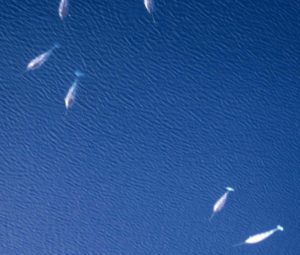
Narwhals in the Creswell Bay (at Somerset Island), Author Ansgar Walk, August 01, 1997, Creative Commons Attribution-Share Alike 2.5 Generic license.
Both Norway and Russia, whose waters form part of the narwhal’s range, have prohibited hunting since 1956. Narwhal hunting is prohibited in the US as well under the Marine Mammal Protection Act. There is no legal trade in narwhal items domestically; only verified antiques and specimens for scientific purposes may be sold and exported or imported with CITES documentation.
The narwhal is currently hunted only in Canada and Greenland, where hunting for food and skins, and the carving of narwhal tusks are all essential to the economy of Arctic peoples. Canadian and Greenland authorities have reported that trade in tusks is not a primary incentive for the hunt by Native peoples; it is a well-regulated byproduct of hunting activities for traditional sustenance.
Only Inuit are permitted to hunt narwhals in Canada and Greenland; communities are set a quota of from five to 50 animals. The Inuit communities in Canada use only 73-88% of the quota of hunted narwhal they are allowed each year. Narwhal cannot be legally possessed, traded, or transported from one Canadian province to another unless a Marine Mammal Tag is attached to the tusk or carcass. Export requites CITES documentation.
In Greenland, hunters must apply for a license before each hunt and afterward must fill out a reporting form for every animal taken or wounded. The hunter must sign the permit which travels with the carcass or tusks when it is sold. Only professional hunters are allowed to sell meat or tusks. No export is allowed.
In the five years from 2005 through 2009, trade records showed that 892 non-antique narwhal tusks were exported in all of international trade, almost all from Canada. In the same years, international imports were documented at 912, showing that almost all the trade in non-antique narwhal was from the highly regulated source countries, with only 20 tusks having a different point of origin – that is, averaging four per year. That is hardly a significant international trade.
The largest number exported to any one country was 235 to Denmark over that five-year period.[v] The UK did not appear among the top ten countries (62 tusks total were listed as going to 21 other countries not specifically listed.) Over this 5-year period, there were 12 tusks listed as educational and scientific exports, 691 for personal use, and only 209 for commercial purposes.
Whalebone: Antique dresses and corsets could be illegal to collect, trade.

Humpback whale (Megaptera novaeangliae), Resurrection Bay, Seward, Alaska, United States, Author Diego Delso, delso.photo, License CC-BY-SA, 21 August 2017.
The challenges to whale populations are complex and cannot be summarily dealt with here. The chief question, however, is the effect of a ban on trade in whale products, in this case, the proposed expansion of the UK’s Ivory Law to whalebone. Globally, whale populations are not threatened by trade in bone, but by the demand for meat and blubber. It can be categorically stated that whalebone is no longer a commercial commodity in the UK.
Iceland, Japan, and Norway are the only countries with a significant commercial whaling industry. There is no longer any widespread use of whale products in Europe or the US (where whale meat is illegal except in the Arctic). Whale meat is not consumed in the UK. It is, however, a staple of the diet of Arctic peoples, and controversially, is consumed by many people in Japan.
While whalebone is now only found in antique objects in the UK, one aspect of a proposed extension of the Ivory Law to whalebone would be the crushing impact on trade and collecting of antique costumes, particularly women’s garments. Whalebone was used for panniers, corsets and other undergarments, and was ubiquitous in women’s dresses from the 18th and 19th centuries. If antique whalebone could no longer be sold in the UK, the collecting and trade of antique costume would come to a sudden end.
Warthogs? Yes, warthogs.

Common warthog (Phacochoerus africanus), Khama Rhino Sanctuary, Botswana, Author Diego Delso, elso.photo, License CC-BY-SA, 2 August 2018.
It seems unlikely that a generation weaned on The Lion King will ever start wearing jewelry or collecting knickknacks made from warthogs. No generation prior to the “Simba” generation has ever wanted to. And no generation afterward is likely to do so either, given the most recent release of the live action movie Lion King with real animals. It would be like wearing Lassie.
While the warthog is killed in Africa for raiding agricultural fields in search of wheat, rice, beans, and groundnut, they are not killed specifically for their tusks. Although the warthog is a tough animal that can live as much as 25 days without water, subsisting on earthworms in the wet season and roots and tubers in the dry, the current threat to warthogs is climate change, because their habitat is increasingly subject to drought.
As with every other species with a tusk or large tooth, some objects made from warthog tusks continue to be collected in China and Southeast Asia. Not so in the UK.
Hippopotamus teeth do not compete with elephant ivory, legal or illegal

Hippo (Hippopotamus amphibius), Chobe National Park, Botswana, Author Diego Delso, delso.photo, 28 July 2018, License CC-BY-SA.
International trade in the hippopotamidae (hippopotamuses) is regulated under CITES,[vi] the Convention in International Trade in Endangered Species, where the Hexaprotodon liberiensis and Hippopotamus amphibious are listed in Appendix II. Appendix II species are not now threatened with extinction but are at risk if their trade is not closely controlled.
While there is a trade in contemporary hippo teeth, it is only with Southeast Asia, Hong Kong, and China. Some environmental organizations say they are concerned that, “there is a real risk that poaching and trafficking could shift to the ivory from hippos.” However, given the haphazard enforcement of laws in many African nations, the low value and small size of hippo teeth and the continuing illegal trade in poached elephant ivory from Africa to East Asia, it is neither logical nor practical for smugglers to make the switch. The argument for banning hippo ivory appears to be relevant for Asian markets only, or as a form of moral argument against trade in wildlife per se, not with respect to UK collecting or trade.
Mammoth ivory: banning trade in long extinct animal parts has no conservation value.
Climate change has sparked a new commercial trade. Scientists in Yakutia say that the melting of permafrost is exposing vast quantities of thousands of years-extinct mammoth bones and tusks each year. Virtually all of the estimated 100 tons per year of mammoth tusks exported from Yakutia is making its way to Chinese and southeast Asian markets, where it is seen as an ethical alternative to elephant ivory. Yakutian official Vladimir Prokopyev estimates that Yakutia holds around 500,000 tons of mammoth ivory. While officials are concerned about developing a new regulatory structure, they also warn that trying to halt the trade could harm locals who have found new and lucrative professions collecting and selling mammoth ivory to China.
Proponents of broad anti-ivory laws would prefer to eliminate all trade, and see mammoth ivory as either a threat to educational campaigns to eliminate ivory trade, or as a possible means of covering up trade in elephant ivory by calling it “mammoth.”
UK trade in mammoth ivory is very small. Unlike the situation in China, there is no known market in the UK for recently crafted items made of mammoth from Yakutia. A limited number of fossilized or ancient mammoth items undoubtedly enter the UK annually through the tourist trade, and dealers and collectors of antique Native Alaskan artifacts may have a few objects in inventory, but there is no significant market in decorative objects made from mammoth ivory at this time.
Preserving animal populations is a crucial goal, as is preserving access to artworks made in ages past from animal source materials. Based on the data supplied through wildlife experts and conservation organizations, individuals and governments can make rational decisions that honor both the goals of sustainability and of preservation of objects of historical value, and both can be saved.
[i] Marine Mammal Protection Act, 16 U.S.C. §1361-1407 (1972) The 1972 US Marine Mammal Protection Act protects sea otter, walrus, polar bear, dugong, and manatee. The Act prohibits the taking and trading of marine mammals and their products but allows certain exemptions under State management. New marine mammal ivory may be carved only by Alaska Natives and sold only after it has been carved. Old ivory can be carved by non-Natives. Fossilized mammoth ivory may be used by both Alaska Natives and non-Natives. Beach-found ivory is legal to own if registered, but cannot be bartered or sold. Fossil ivory may not be collected on any State or federal lands but may be collected on private lands with permission of the owner.
[ii] Hauling Out: International Trade and Management of Walrus, by Tanya Shadbolt, Tom Arnbom, and Ernest W.T. Cooper, A TRAFFIC Report, World Wildlife Fund, 2014.
[iii] Id., p.7.
[iv] Breaking the Ice: International Trade in Narwhals, in the Context of a Changing Arctic, by Tanya Shadbolt, Ernest W.T. Cooper, and Peter J. Ewins, A TRAFFIC and WWF-CANADA Report, World Wildlife Fund, 2015.
[v] Id., p 51.
[vi] How CITES Works, “All import, export, re-export and introduction from the sea of species covered by the Convention has to be authorized through a licensing system… The species covered by CITES are listed in three Appendices, according to the degree of protection they need.” https://www.cites.org/eng/disc/how.php
This article is intended to convey general information only and is not intended to provide legal advice. The contents of this report should not be construed as or relied upon for legal advice in any particular circumstance or fact situation. There may be other laws or regulations that could affect the interpretation of certain provisions of the relevant laws which are referred to in this report. Legal advice should be obtained from legal counsel when dealing with specific circumstances.
 Common warthog (Phacochoerus africanus), Khama Rhino Sanctuary, Botswana, Author Diego Delso, delso.photo, License CC-BY-SA, 2 August 2018.
Common warthog (Phacochoerus africanus), Khama Rhino Sanctuary, Botswana, Author Diego Delso, delso.photo, License CC-BY-SA, 2 August 2018. 

